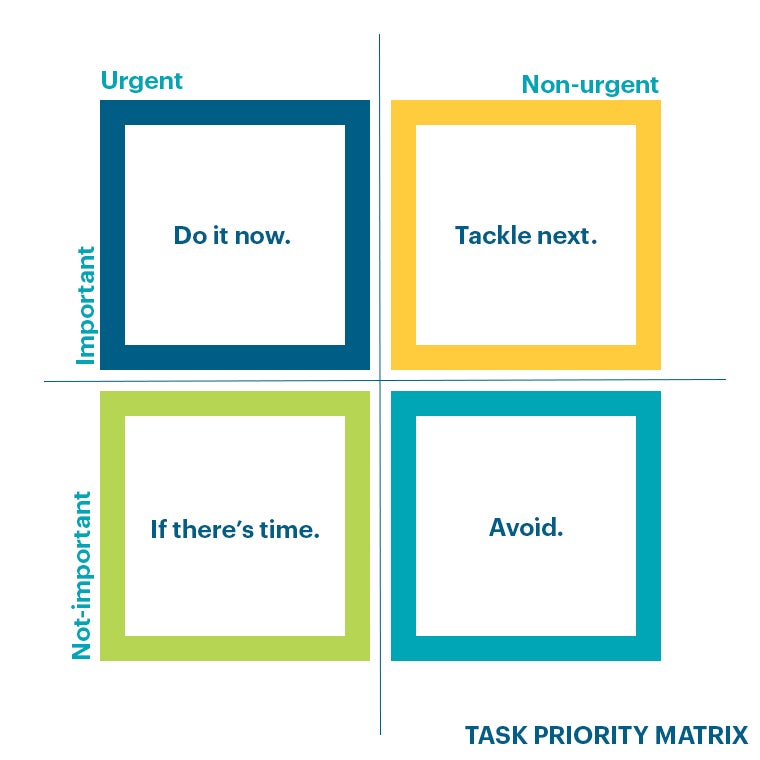
How to prioritise tasks
17 March 2022
So, it’s 9.00am, and you’ve written your to-do list for the day. You’ve included everything from today’s classes to the set readings for next week’s tutorial, from brainstorming ideas for your upcoming research project to writing the abstract for your thesis. You’ve even remembered to put down making that phone call to check in on your best friend who you haven’t seen in weeks.
The problem is that there are only so many hours in the day, everything seems important and it’s starting to feel pretty overwhelming staring at your list. How do you prioritise tasks? The good news is that there are plenty of ways. Here’s why it’s so important to prioritise and how to do so successfully.
The benefits of prioritising
Does it really matter when you do certain tasks, and in what order, if all of the tasks on your list get done eventually? It certainly does matter, as prioritising has some serious benefits, and can transform the way you work. Here are three key benefits of prioritising.
1. Better productivity
Not all tasks on your to-do list are equally urgent, though some will definitely be more important than others. Prioritising helps you clarify what’s most important on your list. Clarifying what’s most important helps you devote your time, energy and attention to achieving these critical tasks, and as a result, you can become more productive.
Prioritising can have some incredible productivity benefits. In fact, according to the Pareto principle, or the 80-20 rule, 80% of results come from the most important 20% of our workload. As a result, prioritising and focusing on the most important 20% on our to-do list can quickly lead to success.
2. Reduced stress
Too many tasks and too little time can quickly lead to overwhelm, which can, in turn, lead to procrastination. When people procrastinate, or put off taking action, it’s usually because they feel there’s simply too much to do and they don’t know where to start. Prioritising your workload can help you reduce your level of overwhelm and the tendency to procrastinate by ensuring that you focus on your most important tasks first.
Prioritising your tasks and achieving actions on your to-do list can help you reduce stress and feel more confident that you can complete your workload.
3. More opportunities
When your to-do list overflows, the last thing you may want is new tasks or opportunities. However, prioritisation can actually lead to more and better opportunities, as completing essential tasks can help you recognise what tasks on your list may actually not need to be done in the first place. Doing so can create room for more important opportunities.
In addition to this, having too much to do and not prioritising can lead you to focus on low-value tasks that may harm your productivity and your career. Prioritising helps ensure that this doesn’t happen and that instead, you can focus on the most important tasks, goals and opportunities.
How to prioritise
Prioritising can increase productivity, less stress and better results. But how do you prioritise? Here are five tips for best-practice prioritisation.
1. Identify important vs urgent tasks
We all tend to prioritise tasks that are urgent. However, it isn't necessarily important just because the task feels urgent. According to Stephen Covey (author of “The 7 Habits of Highly Effective People”), it can help to organise your tasks into four categories:
- Not important and not urgent: These tasks tend to waste your time and often come in the form of procrastination activities, such as surfing the web mindlessly or watching TV. Forget them.
- Urgent and not important: These tasks have little or no value and are usually only ‘disguised’ as urgent. An example might be an email or a phone call you’ve just spent 10 minutes on that wasn’t necessary to you but apparently was to the other party. Reflect on whether the tasks are genuinely urgent (and to whom) before starting on them.
- Not urgent and important: These are vital tasks for long-term benefit (for example, exercising or picking up the phone to catch up with mum), but often don’t need to be done right away. Include them, but be conservative – it may be that you need to break them up and spread them out over a more extended period.
- Urgent and important: Finally, these are the tasks you need to act on immediately. They hold high value and must be done now, such as emergencies or hard deadlines for projects and assessments.

2. Say ‘no’
When people ask you to do something, it feels great to say ‘yes’, doesn’t it? It means you give them what they want; it feels safer than the alternative and is much easier than having to decide whether the request is important. Saying ‘yes’ is addictive. The problem is when there are only so many hours in the day, and your to-do list already has you at capacity, saying ‘yes’ often means saying ‘no’ to something else. On the other hand, when we say ‘no’ to one thing, it means we’re prioritising other tasks that hold more value to us. The advice here isn’t to immediately refuse, but to thoughtfully consider what’s truly important to you, especially when you’re managing a heavy workload.
As Gandhi said,
“A ‘no’ uttered from deepest conviction is better than a ‘yes’ merely uttered to please, or worse to avoid trouble.”
3. Establish rituals
It's easy to let good habits slip when you find yourself loaded with competing demands and a full schedule. Establishing or re-establishing good habits that become automatic behaviours over time can be the key to ensuring that your prioritised tasks are completed.
You've probably heard the phrase 'work smarter, not harder'. Establishing regular times in your calendar for habitual, essential tasks (such as exercise, brainstorming, mindfulness meditation, even your lunch break!) will allow you to put more energy into those irregular, yet urgent and important tasks that come up.
Habits become automatic behaviours that become rituals.
For example, you might have ‘take a 30-minute walk’ on your to-do list. Allocate a specific time for this – say, 1.00pm, after your lunch break. Ritualising this activity means you can effectively cross it off your list in advance, and your other tasks can be met with more energy.
4. Use the ‘value vs effort’ matrix
If you’re still debating whether one task is more important than the other and can’t decide whether another task is urgent enough to begin right away, another way of prioritising tasks is to consider their value and how much effort will be required to complete them.
It’s important to establish whether tasks are worth forgetting, worth doing right away, or should be broken down into smaller, more manageable chunks. A way to identify which of your tasks fall into which category is with a value vs effort matrix:
Low value and high effort
Forget it. If you’ve included a task in this quadrant, it’s probably not even worth doing. Reflect on why the task exists, and if it must still be done, move it to another quadrant.
Low value and low effort
These are ‘filler’ tasks. Any task that falls into this quadrant is probably already old, and you’re hanging on for sentimental reasons. Again, reflect on why these tasks exist, and if you can’t get rid of them, move them to another quadrant.
High value and high effort
Chip away. Break these tasks down into smaller, more manageable chunks that you can work on over a longer period of time. They’re a high priority, but as they stand, they’re probably going to require too much effort to be completed quickly.
High value and low effort
Do it now. These tasks are the highest priority, and you should consider getting them done first. Considering they’re low effort, they should come at little or no expense to the other tasks on your to-do list.
5. Set a productive tone for the day
Prioritising is all well and good, but a prioritised to-do list isn’t very helpful if procrastination gets in the way of achieving anything. For this reason, it’s important to put your prioritisation into action by setting a productive tone for the day.
The best way to do this is by employing a strategy that productivity experts call ‘eating the frog’. The strategy refers to a quote attributed to Mark Twain:
“If you have to eat a live frog, it does not pay to sit and look at it for a very long time!”
In a nutshell, when you’re prioritising, ensure that you put a ‘frog’, or a large and important task, at the top of your to-do list. Doing a big and important task first will help set the right tone for your day, and ensure that you have the momentum, inspiration and energy to continue having a productive day.
Beware of bias, and be realistic with your time
We often demonstrate bias when it comes to categorising tasks as being high value. Put simply, we feel that if it was worth including on our to-do list (or it’s a prescribed task, such as reading a 100-page chapter of the unit text), it must have value. What happens is you end up flooding the high-value, low-effort quadrant with tasks, and those with higher effort are sacrificed.
The solution for how to prioritise tasks is to be realistic with your time, reflect on your to-do list and say ‘no’ to those tasks that actually aren’t all that important.
Find out more about how you can put these tips into practice and set yourself up for success through SCU Online’s flexible and affordable online courses, or speak to one of the friendly Student Enrolment Advisors today on 1300 863 819.
